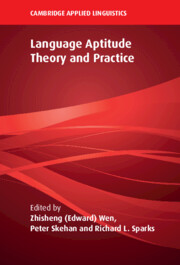Book contents
- Language Aptitude Theory and Practice
- The Cambridge Applied Linguistics Series
- Language Aptitude Theory and Practice
- Copyright page
- Contents
- Figures
- Tables
- Editors and Contributors
- Preface and Acknowledgments
- 1 Language Aptitude Research
- Part I Revisiting and Refining Aptitude Tests
- 2 The MLAT-Elementary
- 3 Testing Language Aptitude
- 4 The High-Level Language Aptitude Battery (Hi-LAB)
- 5 Exploring the Predictive Validity of the LLAMA (v1) Language Aptitude Tests
- Part II Aptitude Testing of Diverse Groups
- Part III Innovative Perspectives and Paradigms
- Part IV Aptitude–Treatment Interaction (ATI)
- Part V Final Commentaries
- Index
- References
5 - Exploring the Predictive Validity of the LLAMA (v1) Language Aptitude Tests
A Research Synthesis
from Part I - Revisiting and Refining Aptitude Tests
Published online by Cambridge University Press: 27 May 2023
- Language Aptitude Theory and Practice
- The Cambridge Applied Linguistics Series
- Language Aptitude Theory and Practice
- Copyright page
- Contents
- Figures
- Tables
- Editors and Contributors
- Preface and Acknowledgments
- 1 Language Aptitude Research
- Part I Revisiting and Refining Aptitude Tests
- 2 The MLAT-Elementary
- 3 Testing Language Aptitude
- 4 The High-Level Language Aptitude Battery (Hi-LAB)
- 5 Exploring the Predictive Validity of the LLAMA (v1) Language Aptitude Tests
- Part II Aptitude Testing of Diverse Groups
- Part III Innovative Perspectives and Paradigms
- Part IV Aptitude–Treatment Interaction (ATI)
- Part V Final Commentaries
- Index
- References
Summary
The LLAMA language aptitude test battery (Meara, 2005) has figured in about 50 published studies, but few have directly addressed how well it actually does the job of predicting variance in language acquisition. One way of evaluating the external (criterion-related) validity of an aptitude test is to systematically examine its correlations with learning outcomes. The present chapter reports on a systematic review of previously published correlations between LLAMA and various L2 tasks (e.g., grammaticality judgments, pronunciation, or overall L2 proficiency). The review reveals that although several of the included studies did find significant correlations between LLAMA scores and L2 tasks, samples were often small, and many studies, often those with larger sample sizes, reported ambiguous or near zero correlations with the outcome, and this in cases where positive associations between aptitude and L2 outcomes would theoretically be expected. The review also revealed that the four LLAMA tests have been unevenly represented in research and that more studies using the full LLAMA suite in correlational designs with a variety of L2 outcomes would be desirable in order to evaluate the external validity of the LLAMA. At present, there is a need for caution when researchers base their findings on correlations with LLAMA because too little is yet known about its predictive validity.
- Type
- Chapter
- Information
- Language Aptitude Theory and Practice , pp. 94 - 116Publisher: Cambridge University PressPrint publication year: 2023
References
- 3
- Cited by

